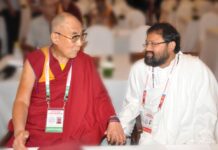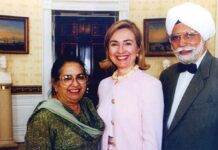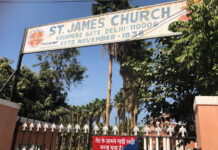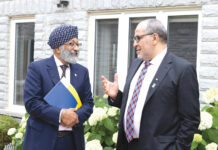News East West
MINNEAPOLIS: Few Indian American doctors can boast a better pedigree than Dr Inder Anand, professor of medicine at the University of Minnesota and director of the Heart Failure Program at the VA Medical Center in Minneapolis.
His late father, Dr Santokh Singh Anand, was one of the founders of India’s prestigious Post-Graduate Institute of Medical Education and Research – known as PGI – in Chandigarh.
And following in his dad’s footsteps, young Anand won a Rhodes scholarship in 1966 to earn a D.Phil in cardiovascular physiology from Oxford. “I was a contemporary Rhodes scholar of Bill Clinton at Oxford,’’ says Dr Inder Anand.

After becoming a full-fledged clinical cardiologist when he returned to India to serve at the PGI in 1976, he had a bagful of experience —from the UK MRC, the Clinical Research Centre at Harrow, the National Hospital for Nervous Diseases, and Kings College Hospital London and the National Heart and Lung Institute, London.
Immediately, the young doctor set about putting that experience to use by creating one of India’s first interventional cardiology programmes and doing pioneering work in two areas — congestive heart failure and high-altitude medicine and biology.
In the case of congestive heart failure, his research shed light on the pathophysiology of salt and water retention, proving that the stimulus for fluid retention is a threat to the arterial blood pressure that is common to all congestive states independent of cardiac function.

And to investigate first-hand the effects of high altitude on the cardiovascular system, Dr Anand went places — from the Siachen Glacier to the mountains of Tibet and Bolivia.
“When I was a medical student during the 1962 war with China, I heard cases of a strange sickness among unacclimatized Indian soldiers sent to fight the Chinese at high altitudes in the Himalayas. They developed what was then an unknown condition called High-Altitude Pulmonary Edema or HAPE. It caused the soldiers to cough up blood and feel breathing difficulties,’’ recalls Dr Inder Anand.
[A similar but less acute mysterious illness affected the Indian solders fighting the Pakistanis at extreme altitudes of 18,000 to 23,000 feet on the Siachen glacier in the late 1980s. Dr Anand’s work on these soldiers led to the discovery of a new disease, “Adult Subacute Mountain Sickness”, related to prolonged stay at those altitudes. This condition became less common when the tenure of stay at these extreme altitude was reduced]

His later expeditions to the Siachen and Tibet highlands led him to pioneer the use of inhaled nitric oxide for managing High-Altitude Pulmonary Edema or HAPE in soldiers.
Dr Inder Anand proved that biological adaptation was the reason why mountain people and animals (yak) survived in high altitude whereas plains people couldn’t. It was because people and animals indigenous to the mountains lacked vascular smooth muscle in the pulmonary arterioles, which resulted in low lung artery pressure and thus normal breathing.
After 15 years at the PGI where he could have become the next boss, Dr Anand suddenly changed career gears.
“I got a no-strings offer from the University of Minnesota and VA Medical Centre to set up a new department of heart failure research. They said you come and see the place first. So I came to the US — my visit coinciding with the meeting of the American Heart Association in November 1990 — and met them and was interviewed. I told them that I won’t write any exam and will come only at the level of a professor. They accepted all my conditions and organized everything – green card, etc. I landed here on November 9, 1991, and still going strong,’’ laughs Dr Anand.

He says his father was very upset with his decision to leave for the US. “My father didn’t want me to leave India. As for me, I was the boss of cardiology and knew just everybody who mattered. But I said: let me give it a try. I took two-year leave and came the US. Back in India, they kept calling me, saying that I would be the next director of the PGI – I was very senior there,’’ he says.
After a pause, Dr Anand adds, “I had helped organize computerization of PGI’s patient records. In fact, we bought the first computer from Infosys when nobody knew that company at that time. The local Infosys guy used to bring computers on the back of his bicycle.’’
So why did he leave India?
It was the stifling culture that forced him to leave, he says. “Unlike the IITs, the politicians didn’t make the PGI independent of their control. Its governing body was under their thumb. These things made me think whether I will be able to do things I wanted to do. That’s why I left,’’ says Dr Anand.

Looking back on his years in the US, he says, “I had no difficulty in adjusting here because I had done my clinical training in the UK. I didn’t have to do any three-year residence or two-year fellowship, etc, as I straightaway got the same role here that I had in India.
“I was the first Sikh in (the) medicine at the University of Minnesota and not even for a day did I suffer any discrimination. On the contrary, I was the beneficiary of positive discrimination as everybody went out of their way to help me. When we bought our home, we were welcomed with banners and there was a night party for us.’’
But more than anything else, he says, he cherishes the compliments he has got from his patients and colleagues over the years.
“Now, I am going on leave, but the patients say they will wait for me to return and get only checked by me. When I tell them that they may have to wait for a long time, they say: they will wait till I return. There can no better compliment than this for a doctor,’’ says Dr Anand.
He is equally effusive in his praise for his colleagues. “There have been occasions when I cannot go to a meeting. They will postpone it rather than go ahead with it. That is the best compliment from my colleagues,’’ he says warmly.
Dr Anand is amazed by the achievements of second and third generations Indians who have got into the medical profession.

“Most of the first generation Indian doctors went into practice because they were not getting higher positions in teaching. But about 10 years before I came here, Indians started getting top teaching positions.
“Now the scenario has changed so dramatically that Indians are holding top teaching positions in the medical profession. There are many big names and they have won top awards. Almost of all of them are second and third generation Indian Americans. They have been accepted because they went to the best schools and colleges in the US,’’ says Dr Anand.
He gives much of the credit for the rise of Indians in the medical profession to Indian parents who, unlike their American counterparts, pay for their children’s education.
“While an average American medical student will end up with a debt of $200,000 when he or she completes his medical credentials, an Indian American student will have no such debt burden because Indian parents pay for their children’s education. That is one of the reason Indian students have better scores than American students. Indian parents consider it their moral duty to see their children through college and university. This is a cultural thing,’’ he says.
Considering these cultural and financial advantages for Indian students, Dr Inder Anand says,“The future of our people is very bright in this country. Look at how they are rising in all professions. Many out of the 35 Rhodes scholars from the US each year are Indian Americans.’’
Very true.
READ ALSO: Birinder Ahluwalia: Dr entrepreneur who made it big in Canada









I had a chance to meet Sir at PGIMER, Chandigarh recently through a senior cardiologist from PGIMER and it turned out to be wonderful experience. He made us to believe in ourselves. He has a positive energy and affects every body around him.
Looking for more such meetings in near future
I had a chance to meet Sir at PGIMER, Chandigarh recently through a senior cardiologist from PGIMER and it turned out to be wonderful experience. He made us to believe in ourselves. He has a positive energy and affect every body around him.
Looking for more such meetings in near future
Read all about inder , felt so proud
Inder is a loss for India but a gain for US. Apart from a successful teacher, he is a loving son, a doting husband and a great friend.
God bless him and his wife, Chandana without whose support he could not have done so well.